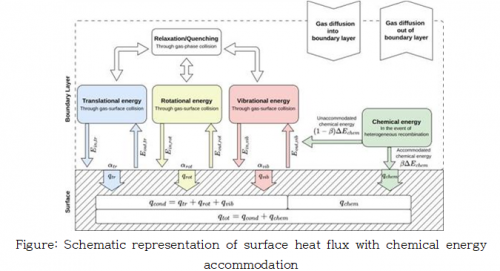Major research outcome
- M.S Candidate Youngil Ko and Professor Eunji Jun, Gas-surface reaction model with chemical energy accommodation
- 관리자 |
- 2024-09-19 13:20:44|
- 165
- 2024-09-19 13:20:44|
The surface of hypersonic vehicles can act as a catalyst for chemical reactions. In particular, exothermic reactions, where nitrogen (N) and oxygen (O) atoms generated by shock layer recombine on the surface, play a dominant role. These reactions are a major contributor to the increased heat flux entering the vehicle's surface. However, not all of the heat released from these reactions is absorbed by the surface; some is partitioned between the translational, rotational, or vibrational energy of the recombined molecules. This phenomenon is known as chemical energy accommodation (CEA). The CEA coefficient quantifies the fraction of heat from these reactions that actually reaches the surface.
Recently, Master’s student Youngil Ko and Professor Eunji Jun developed a surface chemical reaction model within the Direct Simulation Monte Carlo (DSMC) framework, a particle-based numerical flow simulation, incorporating the CEA phenomenon. When the CEA coefficient is unity, all of the heat from the exothermic reaction is transmitted to the surface as heat flux. When the coefficient is less than unity, some of the heat is instead distributed as vibrational energy of the recombined molecules. To account for variations in chemical energy accommodation based on different surface recombination mechanisms, the model is based on finite-rate surface chemistry (FRSC). This research has been published in Volume 36 of the Physics of Fluids(POF) journal in 2024. POF is a leading journal in fluid mechanics, known for publishing rigorous, high-quality research across the field of flow dynamics (Impact Factor: 4.1, ranking in the top 5% of JCR).
https://doi.org/10.1063/5.0222518
Recently, Master’s student Youngil Ko and Professor Eunji Jun developed a surface chemical reaction model within the Direct Simulation Monte Carlo (DSMC) framework, a particle-based numerical flow simulation, incorporating the CEA phenomenon. When the CEA coefficient is unity, all of the heat from the exothermic reaction is transmitted to the surface as heat flux. When the coefficient is less than unity, some of the heat is instead distributed as vibrational energy of the recombined molecules. To account for variations in chemical energy accommodation based on different surface recombination mechanisms, the model is based on finite-rate surface chemistry (FRSC). This research has been published in Volume 36 of the Physics of Fluids(POF) journal in 2024. POF is a leading journal in fluid mechanics, known for publishing rigorous, high-quality research across the field of flow dynamics (Impact Factor: 4.1, ranking in the top 5% of JCR).
https://doi.org/10.1063/5.0222518
| Attach File |
|---|


